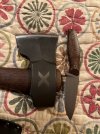I am not an expert, but this style of axes is more suited to the softer green woods of both coniferous as well as deciduous trees typically found in Finland and in the northern boreal forests. The bearded style makes it suitable for rough carving too: one can choke up close to the head and have a better control. For a finer carving you would need a short handle and somewhat thinner bit. The axe shown is a more generalist one: you can use it to fell, delimb and buck smaller trees, to carve green wood and also to split firewood. It won’t excel in felling or splitting, but it will do. It will probably drive well wooden wedges too, though the exaggerated curve of the handle doesn’t facilitate the proper grip for this, you need to choke up. One advantage of the pattern is the quite secure fitting of the head to the handle - it won’t loosen up so easily.
This specific axe has a very nice finish and prioritizes looks over functionality (e.g. handle design). It would be more than fine for bushcrafting.
If you want a hard use axe mainly for splitting and/or felling, I would suggest a North American style or even a German style axe, especially if you plan using it on harder woods like hard maple, oak, beech, hickory or woods with interlocked grain like elm or American sycamore.


